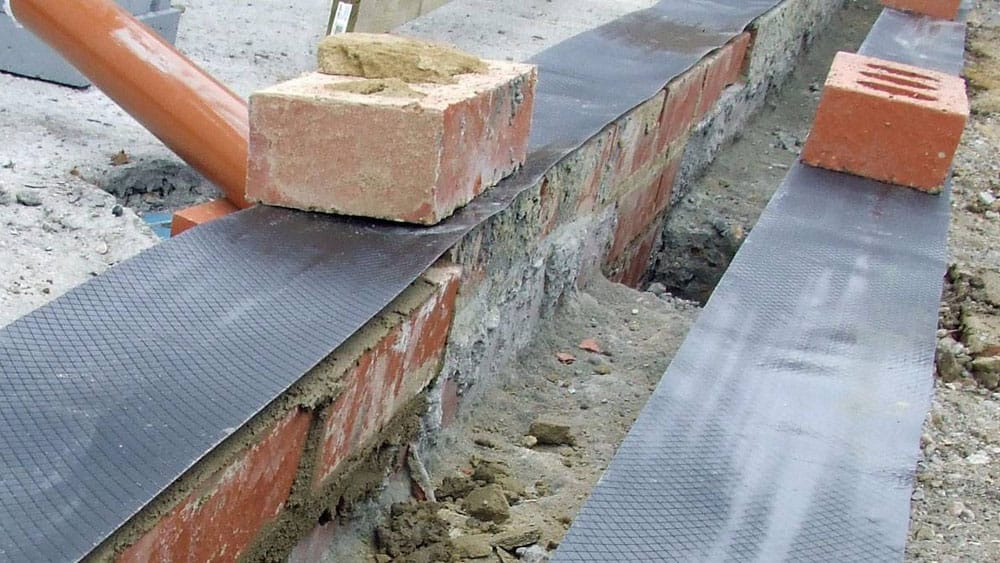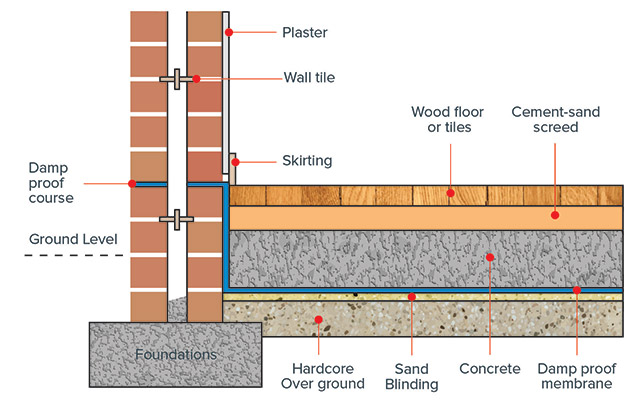Discovering the Numerous Techniques and Solutions for Effective Damp Proofing
Moisture in structures presents substantial challenges to both structural stability and interior air top quality. Various techniques and options have arised to battle this pervasive concern. From conventional damp-proof membranes to cutting-edge chemical treatments, each approach supplies special advantages. Understanding these options is important for reliable moisture control. However, selecting the best service relies on specific building conditions and demands, motivating further expedition into the most efficient moist proofing methods readily available.
Understanding the Sources Of Moisture
Although dampness can emerge from different resources, comprehending these causes is vital for reliable removal. Generally, wetness originates from 3 main resources: rising wet, permeating damp, and condensation. Climbing moist occurs when groundwater takes a trip upwards via porous products, such as block or stone, commonly as a result of a lack of a reliable barrier (damp specialist newcastle). Permeating damp is typically triggered by exterior elements, including roofing system leakages, faulty rain gutters, or harmed walls, permitting water to infiltrate a residential or commercial property. Condensation, on the various other hand, arises from excess wetness airborne, usually worsened by poor ventilation and temperature distinctions, leading to water droplets basing on surface areas. Determining these underlying concerns is necessary, as each sort of moisture needs a customized strategy for removal. Proper assessment helps in establishing one of the most reliable services, ultimately safeguarding the architectural stability of a structure and enhancing interior air quality
Standard Damp-Proof Membranes

Chemical Damp-Proofing Solutions
Chemical damp-proofing solutions provide an ingenious technique to protecting against moisture intrusion in structures. These methods normally include the application of fluid chemicals that permeate stonework and create an obstacle versus rising moist. Frequently used chemicals consist of silanes, siloxanes, and various other water-repellent agents that respond with surface products to develop a hydrophobic layer.The application process typically calls for drilling openings right into the wall surfaces, infusing the chemical option, and allowing it to treat. This technique is particularly helpful for older structures where standard damp-proof membranes might be unwise. Chemical damp-proofing can be much less disruptive and extra cost-effective than comprehensive renovation projects.While effective, these options depend on correct application and ecological problems for peak performance. damp specialist newcastle. Regular upkeep and tracking are necessary to guarantee the long life of the damp-proofing therapy. In general, chemical damp-proofing represents a functional option for protecting structures against moisture-related damage
Tooth Cavity Wall Surface Building Methods
Cavity wall surface building and construction methods provide countless advantages, specifically in moisture control and energy effectiveness. By integrating an air void in between two layers of masonry, these walls effectively mitigate water access while improving insulation. This mix not only safeguards frameworks from moisture but additionally adds to lowered power usage.
Benefits of Dental Caries Wall Surfaces
When thinking about effective damp proofing methods, the benefits of dental caries walls attract attention prominently. Cavity wall surfaces contain two separate layers, creating an air space that properly lowers moisture penetration. This style minimizes the danger of wetness, as the external wall surface acts as a barrier against rain and water access. Additionally, dental caries wall surfaces boost thermal insulation, which contributes to energy effectiveness by minimizing warmth loss. They likewise supply sound insulation, aiding to create a quieter interior setting. Furthermore, the air void enables air flow, which aids in wetness control and lowers the probability of mold and mildew growth. These benefits not just boost the total comfort of a building however additionally add to its durability and architectural stability.
Wetness Control Strategies
Reliable moisture control approaches are important in dental caries wall surface building and construction to guarantee long-lasting protection against wetness. One main method includes the unification of weep holes, which help with water drainage from the tooth cavity, stopping accumulation. In addition, the usage of breathable membrane layers can assist take care of moisture levels while permitting caught vapor to run away. Proper positioning of insulation is additionally crucial, as it must not obstruct water drainage paths. Making certain that the external fallen leaves of the cavity wall are constructed with water-resistant materials improves general sturdiness. Normal upkeep checks are vital to identify any type of clogs or damage early, securing the structure's honesty. Inevitably, a mix of these strategies develops a durable defense versus dampness breach in cavity walls.
Insulation and Power Effectiveness
Insulation plays a vital function in enhancing energy efficiency within cavity wall building and construction. By including insulating products, these walls produce a thermal barrier that lessens warm loss and reduces power usage. Efficient insulation not just aids preserve a secure interior temperature but also reduces the danger of dampness, as it protects against condensation within the wall tooth cavity. Different methods, such as the use of stiff foam boards or mineral woollen, can be utilized to attain perfect insulation efficiency. Furthermore, correct installment is necessary to assure that spaces and gaps are lessened, which can otherwise compromise power performance. Ultimately, a well-insulated dental caries wall contributes greatly to overall sustainability and lowers heating & cooling expenses for property owners.
Exterior Damp Proofing Approaches
Exterior damp proofing methods are necessary for protecting frameworks from wetness infiltration. Two reliable techniques include the application of waterproof membrane layers and the installation of French drains pipes. These options aid alleviate water accumulation and maintain the honesty of structures.
Waterproof Membrane Application
While different approaches exist for avoiding wetness ingress, the application of water-proof membranes remains a very effective outside wet proofing method. These membrane layers are normally made from materials such as polyethylene, rubber, or modified asphalt, providing a durable obstacle against water infiltration. The installation process includes applying the membrane to the external surface areas of walls or foundations, making certain full protection to stop leaks. Appropriate attachment and sealing at joints are essential to making best use of performance. Water resistant membrane layers can be used in numerous forms, including fluid finishings and sheet membrane layers, permitting flexibility based on the details demands of the framework. This method not only safeguards structures from moisture however likewise boosts their durability and architectural integrity.
French Drain Installment
One efficient method for taking care of groundwater and protecting against dampness accumulation around a structure's foundation is the installation of a French drain. This water drainage system includes a trench loaded with gravel and a perforated pipeline that reroutes surface water away from the foundation. Proper installation requires cautious preparation, ensuring that the drainpipe inclines far from the framework to help with optimal water circulation. Furthermore, the location of the drain is vital; it must be placed in locations susceptible to merging or excess dampness. Normal upkeep, including cleaning particles from the gravel and making sure the pipeline remains unhampered, is necessary for lasting efficiency. Ultimately, a well-installed French drain can significantly minimize the threat of water-related concerns in structures and basements.
Interior Waterproofing Approaches
Inside waterproofing techniques are important for shielding a building's interior from moisture infiltration and potential water damages. These methods generally involve the application of specific products and techniques designed to produce a dampness obstacle within the framework. One typical strategy is making use of waterproof finishes or sealants on walls check here and floors, which stop dampness from passing through surfaces.Additionally, mounting indoor water drainage systems, such as sump pumps, can effectively manage water buildup in basements and creep rooms. One more technique entails using vapor barriers, which are set up to prevent moisture motion from the ground right into living spaces.Moreover, attending to any type of splits or voids in walls or structures with ideal sealants assures a thorough defense against water intrusion. By executing these interior waterproofing methods, residential property proprietors can substantially minimize the threat of mold growth, architectural damages, and other moisture-related concerns. Appropriate implementation of these techniques is crucial for long-lasting defense and structure integrity.
Normal Maintenance and Examination Practices
Regular maintenance and evaluation methods are vital for guaranteeing the long-term performance of wet proofing solutions in any structure. Regular checks make it possible for homeowner to determine very early indications of wetness breach, such as peeling off paint, mold growth, and musty odors. These signs can signal underlying problems that require instant attention.Inspections must be carried out at the very least each year, focusing on susceptible locations like cellars, crawl areas, and exterior walls. Throughout these analyses, homeowner need to analyze sealants, water drainage systems, and ventilation to confirm they function correctly.Additionally, keeping gutters and downspouts is crucial, as stopped up systems can lead to water accumulation near the structure. Carrying out a normal maintenance timetable, together with timely repairs, can significantly expand the lifespan of wet proofing actions and shield the structural stability of the building. Aggressive actions eventually add to the total health and wellness and safety of the living atmosphere.
Regularly Asked Concerns
The Length Of Time Does Damp Proofing Normally Last?
The duration of wet proofing performance differs, usually lasting between 20 to 50 years. Elements such as application high quality, environmental problems, and upkeep methods significantly affect the durability of the moist proofing therapy.

Can I Damp Evidence My Home Myself?
The private considered the feasibility of do it yourself damp proofing. With proper study and the best products, it is possible. Nonetheless, they likewise identified the value of specialist assistance to assure lasting performance and prevent future problems.
What Are the Indications of Ineffective Damp Proofing?
Indicators of inefficient damp proofing consist of relentless mildewy odors, noticeable mold development, peeling paint, moist spots on walls, and wood degeneration - damp removal newcastle. Home owners ought to resolve these problems immediately to avoid additional damages and health and wellness problems
Does Damp Proofing Affect Indoor Air High Quality?

Just How Much Does Specialist Damp Proofing Cost?
Specialist wet proofing expenses vary substantially, typically ranging from $1,000 to $5,000 depending on the property's dimension, the extent of the moist issue, and picked techniques. Each situation calls for a customized analysis for exact prices. Generally, moisture originates from 3 main sources: rising damp, penetrating wet, and condensation. When taking into consideration effective wet proofing methods, the advantages of tooth cavity wall surfaces stand out plainly. Exterior wet proofing methods are essential for shielding structures from wetness seepage. While numerous approaches exist for preventing moisture ingress, the application of waterproof membranes continues to be a very reliable exterior wet proofing method. Indications of inefficient moist proofing consist of persistent mildewy smells, visible mold development, peeling off paint, damp patches on wall surfaces, and timber decay.